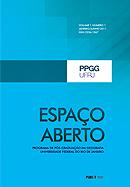Critical Analysis of the van Bemmelen Conversion Factor used to Convert Soil Organic Matter Data to Soil Organic Carbon Data: Comparative Analyses in a UK Loamy Sand Soil
DOI:
https://doi.org/10.36403/espacoaberto.2016.5244Palavras-chave:
Soil Organic Matter, Soil Organic Carbon, Hilton Experimental Site, van Bemmelen Conversion Factor.Resumo
Converting soil organic matter (SOM) data to soil organic carbon (SOC) data usually uses the van Bemmelen factor of 0.58 (or in reverse its reciprocal of 1.724) as a universal conversion factor. The accuracy of this conversion factor has been questioned. Under the Kyoto Protocol (1997) dry combustion is recommended to provide reproducible analyses to measure soil carbon stocks. However, dry combustion equipment is expensive and entails high maintenance. For rapid and inexpensive measurements, loss-on-ignition (LOI) is often used. A total of 278 loamy sand topsoil (0-5 cm depth) samples were taken during three soil sampling sessions (9 January 2007, 22 January 2009 and 10 October 2011) from runoff plots, splash erosion plots and grassed/cultivated plots on the Hilton Experimental Site, Shropshire, UK. A total of 124 soil samples were collected from both runoff and splash plots in both 2007 and 2009 (Bhattacharyya et al., 2011a). Some 22 of the collected samples in 2011 were from grassland (Ah horizon) and eight from cultivated soils (Ap horizon). Homogenized soil samples were split and SOM was determined on oven-dried samples by LOI and total SOC was determined by dry combustion. A conversion factor of 0.845 was used to obtain SOC from total soil C, following Rawlins et al. (2011). Results showed strong associations (R² = 0.70, P <0.001, n = 278) between SOM and SOC data. For all data, SOM to SOC conversion factors varied between 0.36-0.98, with a mean value of 0.66 (SD = 0.105). The mean values of the conversion factor were 0.64, 0.69 and 0.56, respectively, for the samples collected in 2007, 2009 and 2011. Results indicate the van Bemmelen factor (0.58) is a reasonable predictor, but both temporal and spatial variations occur around it within a specific soil type. Thus, caution should be exercised in SOM/SOC data conversions using the van Bemmelen factor.


